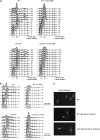Histone H3 K56 hyperacetylation perturbs replisomes and causes DNA damage
- PMID: 18579506
- PMCID: PMC2516057
- DOI: 10.1534/genetics.108.088914
Histone H3 K56 hyperacetylation perturbs replisomes and causes DNA damage
Abstract
Deacetylation of histone H3 K56, regulated by the sirtuins Hst3p and Hst4p, is critical for maintenance of genomic stability. However, the physiological consequences of a lack of H3 K56 deacetylation are poorly understood. Here we show that cells lacking Hst3p and Hst4p, in which H3 K56 is constitutively hyperacetylated, exhibit hallmarks of spontaneous DNA damage, such as activation of the checkpoint kinase Rad53p and upregulation of DNA-damage inducible genes. Consistently, hst3 hst4 cells display synthetic lethality interactions with mutations that cripple genes involved in DNA replication and DNA double-strand break (DSB) repair. In most cases, synthetic lethality depends upon hyperacetylation of H3 K56 because it can be suppressed by mutation of K56 to arginine, which mimics the nonacetylated state. We also show that hst3 hst4 phenotypes can be suppressed by overexpression of the PCNA clamp loader large subunit, Rfc1p, and by inactivation of the alternative clamp loaders CTF18, RAD24, and ELG1. Loss of CTF4, encoding a replisome component involved in sister chromatid cohesion, also suppresses hst3 hst4 phenotypes. Genetic analysis suggests that CTF4 is a part of the K56 acetylation pathway that converges on and modulates replisome function. This pathway represents an important mechanism for maintenance of genomic stability and depends upon proper regulation of H3 K56 acetylation by Hst3p and Hst4p. Our data also suggest the existence of a precarious balance between Rfc1p and the other RFC complexes and that the nonreplicative forms of RFC are strongly deleterious to cells that have genomewide and constitutive H3 K56 hyperacetylation.
Figures








Similar articles
-
The sirtuins hst3 and Hst4p preserve genome integrity by controlling histone h3 lysine 56 deacetylation.Curr Biol. 2006 Jul 11;16(13):1280-9. doi: 10.1016/j.cub.2006.06.023. Curr Biol. 2006. PMID: 16815704
-
Cell cycle and checkpoint regulation of histone H3 K56 acetylation by Hst3 and Hst4.Mol Cell. 2006 Jul 7;23(1):109-19. doi: 10.1016/j.molcel.2006.06.006. Mol Cell. 2006. PMID: 16818235
-
Interplay between histone H3 lysine 56 deacetylation and chromatin modifiers in response to DNA damage.Genetics. 2015 May;200(1):185-205. doi: 10.1534/genetics.115.175919. Epub 2015 Mar 18. Genetics. 2015. PMID: 25786853 Free PMC article.
-
Histone H3 lysine 56 acetylation: a new twist in the chromosome cycle.Cell Cycle. 2006 Nov;5(22):2602-8. doi: 10.4161/cc.5.22.3473. Epub 2006 Nov 15. Cell Cycle. 2006. PMID: 17172838 Review.
-
The Amazing Acrobat: Yeast's Histone H3K56 Juggles Several Important Roles While Maintaining Perfect Balance.Genes (Basel). 2021 Feb 25;12(3):342. doi: 10.3390/genes12030342. Genes (Basel). 2021. PMID: 33668997 Free PMC article. Review.
Cited by
-
Genetic inhibitors of APOBEC3B-induced mutagenesis.Genome Res. 2023 Sep;33(9):1568-1581. doi: 10.1101/gr.277430.122. Epub 2023 Aug 2. Genome Res. 2023. PMID: 37532520 Free PMC article.
-
Rtt107 Is a Multi-functional Scaffold Supporting Replication Progression with Partner SUMO and Ubiquitin Ligases.Mol Cell. 2015 Oct 15;60(2):268-79. doi: 10.1016/j.molcel.2015.08.023. Epub 2015 Oct 1. Mol Cell. 2015. PMID: 26439300 Free PMC article.
-
Environmental change drives accelerated adaptation through stimulated copy number variation.PLoS Biol. 2017 Jun 27;15(6):e2001333. doi: 10.1371/journal.pbio.2001333. eCollection 2017 Jun. PLoS Biol. 2017. PMID: 28654659 Free PMC article.
-
Genetic-variant hotspots and hotspot clusters in the human genome facilitating adaptation while increasing instability.Hum Genomics. 2021 Mar 19;15(1):19. doi: 10.1186/s40246-021-00318-3. Hum Genomics. 2021. PMID: 33741065 Free PMC article.
-
PCNA Loaders and Unloaders-One Ring That Rules Them All.Genes (Basel). 2021 Nov 18;12(11):1812. doi: 10.3390/genes12111812. Genes (Basel). 2021. PMID: 34828416 Free PMC article. Review.
References
-
- Allen, J. B., Z. Zhou, W. Siede, E. C. Friedberg and S. J. Elledge, 1994. The SAD1/RAD53 protein kinase controls multiple checkpoints and DNA damage-induced transcription in yeast. Genes Dev. 8 2401–2415. - PubMed
Publication types
MeSH terms
Substances
Grants and funding
LinkOut - more resources
Full Text Sources
Other Literature Sources
Molecular Biology Databases
Miscellaneous

